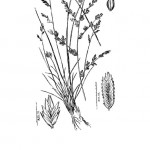Red Lovegrass
Eragrostis secundiflora
Poaceae
Description
Red Lovegrass is highly variable. Being red is not a reliable characteristic. It is a weedy, branching, spindly grass that is not similar to Plains, Weeping, or Sand Lovegrass. This tufted, erect bunchgrass can grow up to28 inches or 70 cm. Sheaths are hairy at the throat, covering half the internode. Its blades can grow up to 20 cm by 2.5 mm. The loosely contracted panicle reaches up to 30 cm long by 15 cm wide, is oblong and open, and appears green to dark purple changing to yellow at maturity. Its strongly compressed, green, light violet, blue-green, or reddish-brown spikelets bear ten to 25 overlapping florets and are borne nearly to the branch bases. Bloom time begins in April with seed production occurring from May to June given enough moisture. The seeds are on very short branches and quite a bit larger than in other Lovegrass species. Red Lovegrass is a perennial, warm-season, native but provides poor grazing for wildlife and cattle.Habitat
Red Lovegrass grows on the upland sandy soil of prairies and open woodlands. It can be a good grass for livestock grazing when managed as a pure stand. It invades overgrazed and disturbed areas as well as roadsides.Images
Plant Characteristics
Seed Type: Non-Encapsulated
Duration: Perennial
Stem Texture: Hairy
Growth Habit: Bunch grass, Grasses
Season: Warm
Distribution
 : 01 - Pineywoods, 02 - Gulf Prairies and Marshes, 03 - Post Oak Savannah, 04 - Blackland Prairies, 06 - South Texas Plains, 07 - Edwards Plateau, 08 - Rolling Plains, 09 - High Plains
: 01 - Pineywoods, 02 - Gulf Prairies and Marshes, 03 - Post Oak Savannah, 04 - Blackland Prairies, 06 - South Texas Plains, 07 - Edwards Plateau, 08 - Rolling Plains, 09 - High Plains
Distributions
Distribution refers to the ecological region in Texas that a plant has been found. You can also view a clickable map.
Book: Know Your Grasses (B-182)
Collection: Grasses


